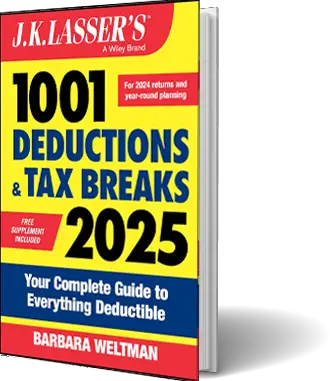
THIS SUPPLEMENT REFLECTS CHANGES THROUGH FEBRUARY 1, 2025
This year’s book, J.K. Lasser’s 1001 Deductions and Tax Breaks, covers the tax rules as they stood on October 1, 2024. The only tax legislation from Congress since then is the Federal Disaster Tax Relief Act of 2023, which was signed into law on December 12, 2024 (and discussed in this Supplement), plus the Employer Reporting Improvement Act of 2024 and the Paperwork Burden Reduction Act of 2024, both of which were signed into law on December 23, 2024. There have been some IRS guidance and court decisions of note.
The changes in this Supplement are listed according to the chapters in which the subject matters appear. I’ve attempted to include an answer to every notation in the book that states “see the Supplement.” Some information covered in this Supplement may apply to 2024 returns; other information applies for purposes of figuring 2025 estimated taxes as well as planning ahead. For changes in 2025, only an overview is provided, with more details to come in the next edition of this book, J.K. Lasser’s 1001 Deductions and Tax Breaks 2026.
Introduction
Standard deduction amounts. The basic standard deduction amounts are increased for 2025 (not on 2024 returns) due to cost-of-living adjustments as follows:
Married filing jointly and surviving spouses: $30,000 (up from $29,200).
Heads of households: $22,500 (up from $21,900).
Singles and married filing separately: $15,000 (up from $14,600).
Additional standard deduction amounts. For 2025, the additional standard deduction amount for age and/or blindness rises to $2,000 for single filers and heads of households and $1,600 for married filers (filing jointly or separately) and surviving spouses.
Chapter 1—Your Family
Dependents. While the personal and dependency exemptions are not deductible in 2018 through 2025, the definition of dependent continues to apply for various tax breaks (e.g., child tax credit; head of household status). In determining dependent status for 2025, a person can be your qualifying relative only if he or she has gross income below $5,200 (up from $5,050 in 2024).
Child tax credit. The refundable child tax credit for 2025 is $1,700 (up from $1,600 in 2024).
As yet, Congress has not changed the rules for the child tax credit. If changes are made, will they be retroactive? Monitor developments.
Earned income credit. The earned income credit amounts, including adjusted gross income limits, have been increased due to a cost-of-living adjustment. As a result, the maximum earned income credit in 2025 is $4,328 for one qualifying child, $7,152 for two qualifying children, $8,046 for three or more qualifying children, and $649 for a taxpayer with no qualifying child.
The earned income credit cannot be claimed if investment income exceeds a set amount. For 2025, the limit is $11,950 (up from $11,600 in 2024).
Adoption credit. The adoption credit limit increases to $17,280 for 2025 (up from $16,810 in 2024). The modified adjusted gross income limits on eligibility for the credit have also been slightly raised for 2025.
Chapter 2—Medical Expenses
Premium tax credit. This refundable tax credit is designed to help individuals pay for the cost of health coverage for themselves and their dependents. To be eligible for the premium tax credit, your household income must be at least 100%, but usually no more than 400% of the federal poverty line for your family size. But as in 2024, the credit may be claimed in 2025 for those with household income above 400%. Eligibility for the credit in 2025 is based on 2024 federal poverty guidelines for the 48 contiguous states and District of Columbia as shown in the following table.
Persons in the family/household
Federal poverty guideline (100%)
1
$15,060
2
$20,440
3
$25,820
4
$31,200
5
$36,580
6
$41,960
7
$47,340
8
$52,720
More than 8
Add $5,380 for each additional person
*The guidelines are higher in Alaska and Hawaii; see https://aspe.hhs.gov/poverty-guidelines.
Employer coverage is affordable—and no premium tax credit may be claimed if such coverage is offered—provided it is no more than 9.02% of household income in 2025 (it was 8.39% in 2024).
Under a final regulation effective January 1, 2025, a “coverage month” means one where the amount of the premium paid, including by advance payments of the premium tax credit, for the month for the individual’s coverage is sufficient to avoid termination of the individual’s coverage for that month.
Itemized medical expenses. The IRS added condoms to the list of qualified medical expenses for 2024 and later years.
For 2025, the IRS medical expense mileage rate is 21¢ per mile (unchanged from 2024).
Nonqualified medical expenses. No change has been made to the treatment of marijuana for medical purposes under federal law. This is so even though even if prescribed by a doctor and legal in the state.
Long-term care coverage. The portion of long-term care insurance premiums that are treated as a deductible medical expense in 2025 (not on 2024 returns) is in the following chart.
Age at the end of 2025
Limitation on premiums
40 or less
$480
More than 40 but less than 50
$900
More than 50 but less than 60
$1,800
More than 60 but less than 70
$4,810
More than 70
$6,020
Flexible spending arrangements (FSAs). In 2025, the maximum salary contribution to a health FSA is capped at $3,300 (up from $3,200 in 2024). The carryover limit of unused benefits in 2025 to 2026 is $660.
Items that can be covered by health FSAs include condoms, over-the-counter birth control, and glucose monitors.
Excepted benefit health reimbursement arrangements (EBHRAs). In 2025, the maximum reimbursement is limited to $2,150 (up from $2,100 in 2024).
QSEHRAs. The maximum employer reimbursement under a Qualified Small Employer Health Reimbursement Arrangement (QSEHRA) for individually-obtained health insurance in 2025 is $6,150 for self-only coverage and $12,450 for family coverage (up from $5,850 and $11,800 respectively for 2024).
Health savings accounts (HSAs). The 2025 minimum and maximum amounts for high-deductible health plans (a prerequisite for HSAs) as well as contribution limits to HSAs have increased slightly:
Type of plan
Minimum deductible under the plan
Maximum out-of-pocket costs
Maximum contribution*
Self-only coverage
$1,650
$8,300
$4,300
Family coverage
$3,300
$16,600
$8,550
*Those age 55 or older by the end of 2025 can add another $1,000, but no contributions are allowed if enrolled in Medicare.
Having a health savings account is predicated on medical coverage under a high-deductible health plan (HDHP). The IRS added the following to the list of expenses that can be covered without a deductible:
Over-the-counter (OTC) oral contraceptives (including emergency contraceptives) and male condoms
All types of breast screening for individuals who have not been diagnosed with breast cancer
Continuous glucose monitors for individuals diagnosed with diabetes
Certain insulin products without regard to whether the insulin product is prescribed to treat an individual diagnosed with diabetes or prescribed for the purpose of preventing the exacerbation of diabetes or the development of a secondary condition
Archer medical savings accounts (MSAs). There are still some individuals covered by these health plans. Again, contributions to MSAs can only be made for those covered by a high-deductible health plan. The limits for 2025 have increased slightly:
Type of plan
Minimum deductible under the plan
Maximum deductible under the plan
Cap on out-of-pocket expenses
Self-only coverage
$2,850
$4,300
$5,700
Family coverage
$5,700
$8,550
$10,500
Accelerated death benefits. For chronically ill individuals, the daily dollar limit excludable from gross income for 2025 is $420 (up from $410 in 2024). Excess amounts are taxable to the extent they exceed actual long-term care costs.
Medicare. The “standard” premium for Part B coverage in 2025, the premium paid by most beneficiaries, is $185 per month (compared with $174.90 per month for 2024). The following table shows the 2025 surcharges and total premiums for higher-income taxpayers, which are based on modified adjusted gross income (MAGI) in 2023.
2023 MAGI for joint filers
2023 for other filers*
Total monthly Part B premium for 2025
Total monthly Part D premium for 2025
Up to $212,000
Up to $106,000
$185.00
Your premium
$212,001 but not over $266,000
$106,001 but not over $133,000
$259.00
$13.70 + your premium
$266,001 but not over $334,000
$133,001 but not over $167,000
$370.00
$35.30 + your premium
$334,001 but not over $400,000
$167,001 but not over $200,000
$480.90
$57.00 + your premium
$400,001 but less than $750,000
$200,001 but less than over $500,000
$591.90
$78.60 + your premium
$750,000 or greater
$500,000 or greater
$628.90
$85.80 + your premium
* Married persons who live with their spouses at any time during the year but filed separately for 2023 are subject to a monthly premium in 2025 of $409.90 for Part B and $78.60 for Part D if 2023 MAGI was over $106,000 but less than or equal to $394,000, or $628.90 for Part B and a monthly premium of $85.80 for Part D if 2023 MAGI was $394,000 or more.
Medical insurance rebates. Private insurers paid out in 2024 about $1.1 billion in Medical Loss Ratio rebates for coverage (up from $950 million in 2023). These rebates to eligible individuals were to be paid to about 5.8 million people by insurers by September 30, 2024.
Chapter 3—Education Costs
Student loan interest deduction. The modified adjusted gross income (MAGI) phaseout range for the 2025 deduction (not on 2024 returns) is $85,000 to $100,000 for singles and $170,000 to $200,000 for joint filers.
Interest on U.S. savings bonds. The modified adjusted gross income limits on eligibility to claim the exclusion for interest on bonds redeemed to pay qualified higher education costs have been increased for 2025. The phase-out ranges for 2025 (not on 2024 returns) are $149,250 to $179,270 for joint returns and $99,500 to $114,500 for all other returns.
Cancellation of a student loan. In the final days of the outgoing Administration, a “final” round of student loan debt relief was approved through an income-based repayment (IBR) plan. According to the Department of Education, the Biden administration approved a total of $188.8 billion in student loan forgiveness for 5.3 million borrowers since taking office. In 2025, a new proposal was introduced in Congress to eliminate the IBR plan, so the status of loan forgiveness going forward is unclear.
ABLE accounts. The annual contribution limit for 2025 is $19,000 (up from $18,000 in 2024).
Chapter 4—Your Home
Real estate taxes. As yet, no change has been made to the SALT cap for 2024. Changes could be made in 2025. Will they be retroactive?
Moving expenses. No deduction can be claimed for work-related moving expenses except for certain military personnel. Those who qualify can figure their move-related driving at 21¢ per mile in 2025 (unchanged from 2024).
Home sale exclusion. There has not been any change to the dollar limit on the exclusion of gain on the sale of a home in which the taxpayer owned and used the home as a principal residence for at least 2 of the 5 years preceding the date of the sale.
Home energy improvements. The IRS updated its Fact Sheet containing Q&As on the energy-efficient home improvement credit and the residential clean energy property credit. Some updates include:
Property not qualifying for the energy-efficient home improvement credit includes:
Window treatments (e.g., blinds, shutters, tinting)
Items installed by a tenant in a rented home or by an owner in a second home or a primary residence in a foreign country, or by a landlord on a home that he or she doesn’t live in (only items installed by an owner on a principal residence located in the U.S. can qualify)
Items installed during construction of a home; only expenditures incurred for an existing home or for an addition or renovation of an existing home can qualify.
In claiming the credit for a residence that is also used for business purposes (e.g., a dwelling unit in which you conduct business), the full credit may be claimed if business use is not more than 20% of total use. If business use exceeds 20%, the credit is limited to the portion of expenditures allocable to the portion of the residence used for nonbusiness purposes.
For owners of a co-op or condominium where qualified expenditures are paid by the co-op or condominium board or management association, they are treated as having paid their proportionate share.
Example: X, a cooperative housing corporation, has 10 tenant-stockholders who are all individuals. Each tenant-stockholder owns 1 share of stock. In 2024, X pays $2,000 for a new exterior door for the building. Each tenant-stockholder is treated as having paid $200 ($2,000 x (1 share of stock per tenant-stockholder/10 total shares of stock)) for the exterior door. Each tenant-stockholder is entitled to claim a tax credit of $60 ($200 x 30%) for the exterior door.
Example: Y, a condo, has 50 resident owners and in 2024, pays $2,000 for a new exterior door for the building. The organizational documents for Y include a Declaration that lists each resident’s percentage interest in common elements based on the proportion of square footage of each dwelling unit to the total square footage of all dwelling units in the building. The Y Declaration shows that Z, an individual dwelling unit owner in Y, has a 10% interest in the common elements, so the Y Board of Directors can determine that Z’s proportionate share of the expenditure for the exterior door is $200 ($2,000 x 10%). Z is treated as having paid $200 for the exterior door. Z’s credit for 2024 for the exterior door is $60 ($200 x 30%)
Labor costs can be taken into account for the credit only for certain expenditures. They may not be included with respect to exterior windows or skylights; exterior doors; and insulation materials and systems (including air sealing materials or systems).
If a credit cannot be used in whole or in part in the current year because there is insufficient tax liability to offset it, the credit may not be carried forward.
The IRS’s Energy Credit Online Portal listing qualified manufacturers (QMs) of certain specified energy property (it does not include insulation) is expected to be available in early 2025. QMs must provide a PIN to the homeowner in order for the homeowner to claim a tax credit.
Incentives, grants, or rebates by the government or a public utility impact the credit.
Subsidies from a public utility: no credit allowed (the subsidies are not taxable to the homeowner).
Rebates: reduction in the purchase price of the property, effectively reducing the amount of the credit.
Grants and other state incentives: Generally, a homeowner is not required to reduce the purchase price or cost of property acquired with a governmental energy-efficiency incentive unless that incentive qualifies as a rebate under federal income tax law. While many states label their energy-efficiency incentives as “rebates” that reduce the purchase price, these incentives may not qualify as rebates under federal income tax law, and the amount of the incentive could be included in the homeowner’s income for federal income tax purposes.
Different rules apply for the residential clean energy property credit. For example, the credit may be claimed for a home that is rented or is a second home, as long as it’s used as the taxpayer’s residence. Landlords can never claim the credit (but they may qualify for an investment tax credit for installing solar panels, etc.). The credit can apply for an existing or newly constructed home. And any unused credit, though not refundable, may be carried forward indefinitely.
Disaster rules for casualties to your home. See Chapter 13.
Chapter 5—Retirement Savings
Traditional IRAs and Roth IRAs. The basic contribution limit for 2025 remains at $7,000; the additional “catch-up” contribution limit is still $1,000 for those who are at least 50 years old by the end of the year. Even though the $1,000 catch-up contribution limit could have been indexed for inflation starting after 2023, there is no change in the limit for 2024 or 2025.
The modified adjusted gross income (MAGI) limits on eligibility to make deductible contributions to a traditional IRA are increased for 2025, as are the MAGI limits for Roth IRAs.
401(k) and similar plans. The elective deferral contribution limit for a 401(k) plan in 2025 is $23,500 (up from $23,000 in 2024). The additional contribution limit is $7,500 for those who are age 50 or older by the end of the year for 2025 (unchanged from 2024). But starting in 2025 there is a higher catch-up limit for those age 60, 61, 62, or 63 in 2025. It is the greater of $10,000 or 150% of the regular catch-up limit ($7,500), making the higher catch-up limit of $11,250.
If an employer adopts a “starter 401(k),” the elective deferral for 2025 is $6,000, plus a $1,000 catchup contribution for those age 50 or older in 2025. These limits have not changed from 2024.
Beginning in 2025, long-term part-timers have a shorter required period of employment in order to qualify for participation in a 401(k). If an employee works at least 500 hours in 2 consecutive years and is at least age 21, they can participate (it was 3 consecutive years in 2024).
Beginning in 2025, plans established after December 22, 2022, must automatically enroll eligible employees in their plans at a salary reduction rate of between 3% and 10% (“elective deferrals”). These employees may opt out or reduce their elective deferrals. This mandatory enrollment rule does not apply to businesses with 10 or fewer employees or new businesses (less than 3 years).
Self-employed retirement plans. The contribution, benefit, and other limits for these plans are increased for 2025. For example, the contribution limit for profit-sharing plans in 2025 is $70,000 (up from $69,000 in 2024).
Simplified Employee Pension plans (SEPs). The contribution limit for these plans for 2025 is $70,000 (up from $69,000 in 2024). The earnings threshold for including an employee in a SEP in 2025 is $750 (unchanged from 2024).
Savings Incentive Match Plans for Employees (SIMPLEs)-IRAs. The 2024 contribution limit for SIMPLE-IRAs and the additional contribution limit for those age 50 or older by the end of the year are $16,500 (up from $16,000 in 2024) and $3,500 respectively (unchanged from 2024).
In 2025, there is an increased deferral limit of $17,600 and increased contribution limit of $3,850 if the employer has 25 or fewer employees receiving at least $5,000 of compensation or has more than 25 but not more than 100 employees and makes either a 4% matching contribution or a 3% nonelective contribution.
Regardless of the size of the employer, starting in 2025, similar to the 401(k)s explained earlier, there are higher catch-up limits for those age 60 to 63: $5,250 (regular catch-up of $3,500 times 150%).
Retirement saver’s credit. The MAGI limits on eligibility to claim the retirement saver’s credit for contributions to IRAs, 401(k)s, and similar plans, as well as to ABLE accounts, have been increased for 2025.
IRAs inherited after 2019. Regulations make it clear that those subject to the 10-year rule must take distributions throughout this period, with the balance distributed at the end of 10 years; distributions cannot be delayed until the end of the 10-year period. But the IRS waived any penalties for distribution failures for inherited IRAs through 2024. Starting in 2025, beneficiaries subject to the 10-year rule must take distributions during this period.
For someone who died in 2020, RMDs for 2025 are figured by starting with the heir’s life expectancy for 2021, the first year in which RMDs should have been taken, and then subtract one for each subsequent year to find the relevant life expectancy.
Example: An individual inherited an IRA from her brother who died in 2020. She did not take any RMD for 2021 through 2024 because of the IRS penalty waiver. In 2025, she begins RMDs. Assume her life expectancy in 2021 was 45.7 years. Her life expectancy for 2025 is 41.7 (45.7 – 4 years).
Charitable transfers of IRA distributions. Qualified charitable distributions from IRAs in 2025 by those age 70½ are limited to $108,000; they were limited to $105,000 in 2024. The limit for QCDs transferred to a charitable remainder trust or gift annuity is $54,000 in 2025 ($1,000 higher than the limit in 2024).
Qualified longevity annuity contracts (QLACs). The maximum amount of funds transferred from an IRA or qualified retirement plan into a QLAC is limited to $210,000, which is up from $200,000 in 2024.
PLESAs. The cap on contributions to a pension-linked emergency savings account (PLESA) in 2025 is $6,000, with a catch-up limit for those at least 50 years old in 2025 of $1,000. These limits are unchanged from 2024. But the definition of highly-compensated employee barred from contributing to a PLESA in 2025 is earnings in 2025 of over $160,000 (up from the 2024 limit of $150,000).
PLESA distributions on Form 1099-R should show code 2 in box 7 if they are treated as an exception to the early distribution penalty.
Disaster distributions. See Chapter 12.
Chapter 6—Charitable Giving
Cash donations. There has been no enactment of a rule for 2024 allowing non-itemizers to claim a deduction for their cash contributions to charity. Monitor developments about the possibility of such a deduction starting in 2025.
Conservation easements. Final regulations issued in October 2024 address syndicated conservation easements after December 31, 2022. The rules discussed in this chapter are unchanged by these regulations.
Leave-based donation programs. The IRS did not announce any leave-based donation programs for 2024 that qualify for special treatment. Monitor developments for 2025 to see if special treatment will be authorized. For example, there may be a designation in light of the California wildfires that began on January 7, 2025.
Chapter 7—Your Car
Business use of your personal car. The IRS announced that the standard mileage rate, used in lieu of deducting the actual costs of business driving, is 70¢ per mile in 2025 (up 67¢ per mile from the rate in effect for 2024). If you use the standard mileage rate for a vehicle you own, you must reduce the basis of your vehicle by 33¢ per mile in 2025 (up from 30¢ per mile in 2024).
Tax credits for clean vehicles. If you purchased a new or previously-owned clean vehicle in 2024 and sold the credit to the dealer, receiving a cash or in the form of a partial payment or down payment for the purchase of the vehicle, or as a reduction in sale price of the vehicle without the payment of cash, you must report certain information on Form 8936, Clean Vehicle Credits, and Schedule A of Form 8936, Clean Vehicle Credit Amount.
The IRS has made it clear that:
If you use a vehicle for both personal and business driving, these credits are available only if the vehicle is used predominantly for personal use.
The transfer of the credit to the dealer does not lower the MSRP of the dealer.
Only the registered owner of the vehicle is eligible for the credit. If a minor is listed as the owner on the seller’s report, the minor must be the tax return filer.
Chapter 8—Investing
Taxable income breakpoints for capital gains rates. The following table shows the break points for capital gain rates for 2025 (this table does not apply to 2024 returns):
Rate
Married filing jointly (and surviving spouse)
Head of household
Single
Married filing separately
0%
Up to $96,700
Up to $64,750
Up to $48,350
Up to $48,350
15%
$96,700 – $600,050
$64,750 – $566,700
$48,359- $533,400
$48,359- $300,000
20%
Over $600,050
Over $566,700
Over $533,400
Over $300,000
Cryptocurrency transactions. Before 2025, you could use a universal or multi-wallet basis allocation methodology to a wallet by wallet or account by account basis allocation methodology. This method treated all digital assets as being held in one wallet, even though they were held in multiple wallets. Starting in 2025, there is a wallet by wallet or account by account basis allocation method using FIFO (first-in, first-out): you to treat disposed digital asset units as the earliest acquired units. But under a transitional rule for 2025, you can make an adequate identification of digital asset units to specify basis rather than using FIFO. Identification is done in one of 2 ways:
Identifying the units by reference to any identifier that would identify the basis and holding period such as the purchase date or purchase price, or
Recording a standing order on your books and records that provide information on the units sold, disposed of, or transferred.
To use this transitional relief in 2025, 6 conditions must be met:
Each remaining digital asset unit must be a capital asset in your hands.
Each unit of unused basis must have been originally attached to a digital asset unit that was a capital asset in your hands.
The digital asset unit from which the unused basis is derived and the remaining digital asset unit must be the same type of digital asset.
You must be able to identify and maintain records sufficient to show the total number of remaining digital asset units in each of the wallets or accounts held by you.
You must be able to identify and maintain records sufficient to show the number of units of unused basis, the original cost basis of each such unit of unused basis, and the acquisition date of the digital asset unit to which the unused basis was originally attached.
You must treat any allocation under this relief as irrevocable.
There has been no legislation applying the wash sale rule to digital asset transactions.
Form 1099-DA will be used by brokers to report digital asset transactions in 2025.
Reminder: If you engaged in any digital asset transaction in 2024, you must answer “yes” to the question on page 1 of Form 1040 or 1040-SR (do not try to submit a form leaving the answer blank). You do not have to check “yes” if you merely hold digital assets but did not have any transactions in the year.
Chapter 9—Travel
Business travel per diem rates. The standard federal per diem rate set by the General Services Administration (GSA) for travel starting October 1, 2024, through September 30, 2025, covering lodging and meals and incidental expenses (M&IE) within the continental United States (CONUS) in most locations is $178 per day ($110 for lodging and $68 for M&IE). There are about 300 locations that have a per diem rate exceeding the standard rate for all or part of the year. These rates can be found from the GSA.
The high-low substantiation rates set by the IRS for areas within CONUS for the period October 1, 2024, through September 30, 2025, are $319 for travel to high-cost localities and $225 for travel to all other areas within CONUS. Of these rates, the meal portion is $86 for high-cost areas and $74 for all other areas within CONUS. The list of high-cost areas has been changed (see Notice 2024-68 for details).
Driving your car for medical purposes or by military personnel under certain conditions. The IRS standard mileage rate for 2025 is 21¢ per mile (unchanged from 2024).
Chapter 10—Real Estate
Deduction for energy-efficient commercial buildings. In 2025 (not on 2024 returns), the deduction is $0.58 increased (but not above $1.16) by $0.02 for each percentage point by which the total annual energy and power costs for the buildings are certified to be reduced by a percentage greater than 25%. The applicable dollar value used to determine the increased deduction amount for property is $2.90 increased (but not above $5.81) by $0.12 for each percentage point by which the total annual energy and power costs for the building are certified to be reduced by a percentage greater than 25%. In both instances, the higher dollar limit applies when wage and apprenticeship rules are met.
Special breaks for certain disaster victims. See Chapter 4 on relief for losses on personal residences.
Chapter 11—Borrowing and Interest
Home mortgage interest. See Chapter 4.
Student loan interest. See Chapter 3.
Borrowing from retirement plans. See Chapter 5.
Investment-related interest. See Chapter 8.
Chapter 12—Insurance and Catastrophes
Disaster losses deduction for nonitemizers. The Federal Disaster Tax Relief Act of 2023, which was signed into law on December 12, 2024, extends the treatment of the deduction for unreimbursed losses from federal disasters for individuals who do not itemize their deductions. They can deduct their losses, minus $500 per event, from their adjusted gross income (essentially an additional standard deduction). The 10%-of-adjusted-gross-income threshold that applies to itemizers does not apply to nonitemizers. This rule applies to disasters occurring between January 1, 2020, and January 11, 2025 (if declared by February 9, 2025).
Disaster relief payments. Relief payments for victims of wildfires and the East Palestine train derailment are tax free. If victims included these payments in their income, they may file for a refund. The Federal Disaster Tax Relief Act of 2023, which was signed into law on December 12, 2024, extends the statute of limitations with respect to wildfire relief payments during tax years beginning after December 31, 2019, and before January 1, 2026.
Disaster areas. Check with FEMA for the latest disaster area declarations.
Accelerated death benefits. For chronically ill individuals, the daily dollar limit excludable from gross income for 2025 is $420 (up from $410 from 2024); excess amounts are taxable to the extent they exceed actual long-term care costs.
Chapter 13—Your Job
Educator expenses. If you are an educator, the cap on the above-the-line deduction for classroom expenses in 2025 is $300 (unchanged from 2024).
Fringe benefits. Note changes for 2025 in dollar limits and other changes for certain employee benefits, including:
Transportation fringe benefits. The monthly exclusion for free parking, transit passes, and van pooling for 2025 is $320 (up from $315 in 2024).
Adoption assistance. The exclusion amount in 2025 for employer-provided adoption assistance is $17,280 (up from $16,810 in 2024).
Dependent care assistance. The cap on dependent care assistance remains at $5,000 in 2025; it is not adjusted annually for inflation.
Performing artists. As yet, there is no change on the adjusted gross income limit of $16,000 for performing artists to deduct expenses without itemizing.
Income earned abroad. The maximum foreign earned income exclusion for 2025 is $130,000 (up from $126,700 in 2024).
Eligibility requirements for 2024 may be waived for certain countries (there were waivers for 6 countries in 2023). The IRS has yet to announce any waivers for 2024 (it did not post the 2023 waivers until March 2024, so check for 2024 waivers that may appear in March 2025).
Wage withholding. If your circumstances have changed since 2024 (e.g., a spouse began to work or stopped working, you had or adopted a child), you may want to file a new withholding form (Form W-4) for 2025 to better estimate tax liability. Those claiming exemption from withholding must file a new Form W-4 by February 18, 2025, to have the exemption effective for 2025. (Normally this would be due by February 15, but it is a Saturday in February, and the next business day—Monday—is President’s Day, so the deadline becomes Tuesday, February 18, 2025.)
Chapter 14—Your Business
Qualified business income (QBI) deduction. The taxable income threshold is slightly higher for 2025 (not for 2024 returns), at $394,600 for joint filers and $197,300 for all other filers (up from $383,900 for joint filers and $191,950 for all other filers in 2024).
Equipment purchases. Some dollar limits and percentages have changed for 2025:
First-year expensing. The deduction limit for 2025 (not for 2024 returns) is $1,250,000 (up from $1,220,000 in 2024). This amount begins to phase out when purchases in 2025 exceed $3,130,000 (up from $3,050,000).
Bonus depreciation. Bonus depreciation, which was 60% in 2024, declines to 40% in 2025 and 20% in 2026, unless changed by Congress. (There is an additional year for property with long production periods.)
Self-employment tax. The wage base for the Social Security portion of the self-employment tax in 2025 is $176,100 (up from $168,600 in 2024).
Standard mileage rate. The IRS announced the standard mileage rate, used in lieu of deducting the actual costs of business driving, is 70¢ per mile for 2025 (up from 67¢ per mile in 2024).
Those who own their vehicles and use the standard mileage rate for 2025 must reduce the vehicle’s basis by 33¢ per mile (up from 30¢ per mile in 2024).
Start-up costs. As yet, there is no change in the rules for deducting start-up costs.
Beneficial ownership information reporting. On December 23, 2024, a federal appellate court lifted a nationwide preliminary injunction on Beneficial Ownership Information (BOI) reporting. FinCEN then said the deadline for BOI action for reporting companies that were created or registered prior to January 1, 2024, would be January 13, 2025. Three days after the appellate court ruling, another panel in the same appellate court reinstated the injunction, and FinCEN reverted to voluntary submissions. On December 31, 2024, the DOJ filed an emergency application with the U.S. Supreme Court asking that the injunction be lifted while an appellate court determines whether the Corporate Transparency Act (CTA), which created BOI reporting, is constitutional. On January 23, 2025, the Supreme Court issued a stay, effectively lifting the nationwide injunction, but there are other cases pending. What’s more, a bill in Congress would repeal the CTA. In view of ongoing litigation, as of January 24, 2025 (after the Supreme Court ruling) FinCEN still says registration is voluntary. Continue to monitor developments.
Chapter 15—Miscellaneous Items
IRS interest rate. The rate for underpayments and overpayments of federal income tax by individuals is 7% for the first quarter of 2025. This rate may be adjusted quarterly.
Gifts you make. The annual exclusion amount for 2025 is $19,000 per recipient (up from $18,000 in 2024). Of course, the recipient can receive any amount tax free; the exclusion impacts only the gift tax, if any, owed by the person making the gift.
Tax audits. The reasonable reimbursement rate for attorney’s fees in 2025 when the IRS’s position is not substantially justified and other requirements are met is $250 per hour (up from $240 per hour in 2024).
Exemption amounts. The AMT exemption amounts for 2025 are (not for 2024 returns) is:
Filing status
2025 exemption
Married filing jointly/surviving spouse
$137,000
Single/head of household
$88,100
Married filing separately
$68,500
Exemption phase-out. The exemption amounts for 2025 start to phase out when alternative minimum taxable income (AMTI) exceeds $1,252,700 for married filing jointly and surviving spouses and $626,350 for other filers.
ABLE accounts. See Chapter 2.







